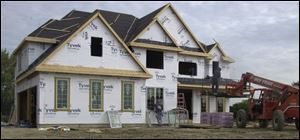
In higher price range, new home construction is preferred
10/12/2002
Low interest rates have spurred demand for houses in the $200,000-$400,000 range, such as this in the Foxgate development in Oregon.
In upper-end housing, it's a case of the glass is half empty or half full.
Existing homes in the $200,000 to $400,000 range are staying on the market longer than they were a year or two ago, but developers and builders continue to find plenty of takers for new houses with those prices from Oregon to Whitehouse to Bedford Township.
They are helped, in part, by historically low mortgage interest rates, which allow purchasers to buy more expensive houses.
“Most of the buyers are people who have sold their second or third homes, and because of the appreciation with their investment many years ago, they're not going in to it with a lot of debt,” said Cecil Adkins, a Walbridge resident who has done a number of subdivisions in the last 40 years. “That's the key.”
For now, low interest rates are outweighing concerns about the economy and a possible war with Iraq, he said. Mr. Adkins said he's very pleased at the pace of his Foxgate subdivision near the intersection of Lallendorf Road and Starr Avenue in Oregon. He received final approvals July 1 and already sold half the lots and has 11 homes under construction. The houses are $250,000 to $300,000.
Gary Obenauf, of Hanifan-Obenauf Builders, Inc., in Waterville, said the market for new houses above $200,000 continues to be strong. His firm has begun Oak Pointe subdivision in Whitehouse, where homes will be $275,000 to $450,000.
“That price range seems to be a good price range for the move-up buyer, from their first home to their second home,” he said. “Five or six years ago, there wasn't a ton of product in that price range, so people bought existing homes. Today, the availability of existing stuff is not quite as great.”
Doug Wamsher, whose MillStream Development Co. in Sylvania has half a dozen subdivisions under way, almost all for upper-end housing, said, “Contractors are busy, they're competitive. People can buy a lot more home today at the rates that are out there.”
He added, “Everybody is questioning the economy, but in my 30 years in the business, I've never seen rates like this.”
But sales have slowed in existing upper-end enclaves in the Toledo area.
John English, a broker/owner of Welles-Bowen Realtors in Toledo, said he has begun to notice hesitation to spend in the $200,000 to $400,000 range.
“I don't want to paint this negative picture. I think this is a cautionary pause,” he said. “If you go back in time 10 to 15 years ago, it's almost laughable to call it slow. It's a slowdown from a very, very hot market ... but homes are sitting longer than they would have in the past.”
Said Rick Smenner,of Re/Max Central Group in Toledo: “That higher price range is a little weak right now, so it's a great time for buyers to be in that market. The good homes are moving fairly quickly, but there's a lot more choices than a year ago.”
The choices, however, are not always quality ones, said Beth Rettig, who, along with her husband, Josh, jumped into the $250,000 range recently for a home in Perrysburg Township.
“When we found the quality that we were looking for in that area, we made an offer pretty quickly,” she said.
Ms. Rettig, who was single when she bought a house in south Toledo just three years ago, said she and her husband knew they would want a bigger house in the suburbs, but upgraded now for a specific reason.
“It was largely the interest rates,” she said. “It was very compelling to do it now. We decided such a home was in our price range.”
Through the first nine months of this year, 671 homes priced from $200,000 to $400,000 sold in the greater Toledo area, out of a total of 5,686. That was up from 629 sold last year in the same time frame.
A noticeable trend, said Mr. English of Wells-Bowen, is buyers seeking out newly built houses rather than existing homes, a trend that may complicate matters down the road.
“I think the market is beginning to maybe be overbuilt,” he said.